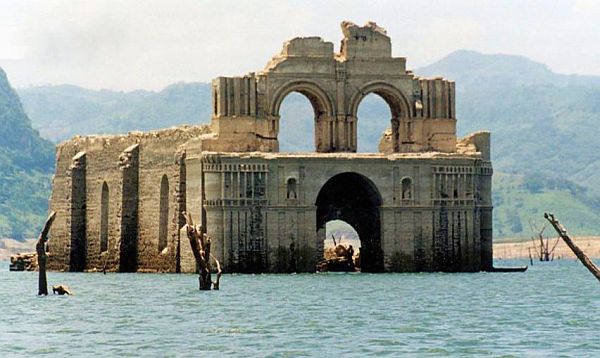Chiapas, Mexico - A 17th-century church in Chiapas that has been covered by water for more than 50 years has once again shown its façade.
The Santiago Apóstol temple emerged after drought caused water levels to drop in the Nezahualcóyotl reservoir on the Grijalva river.
Drought is currently affecting just over one-fifth of Mexico's territory including large parts of the southern states of Chiapas and Oaxaca. The Grijalva river catchment area is considered to be in extreme drought.
The church, built by Dominican friars in the town of Quechula in the mid-1600s, was completely submerged in 1966 as a result of the construction of the Nezahualcóyotl dam, which also flooded other nearby towns, forcing residents to relocate.
One rich landowner, Saúl Pérez, is said to have refused to leave his ranch but was forced to do so when water began lapping at his feet. His riches, including 3 chests of gold, were left behind and are believed to be buried under tonnes of sand at the bottom of the dam.
It's only the third time since the reservoir's completion that water levels have dropped enough to reveal the entirety of the colonial-era structure.
Despite being under water for more than half a century – and its age – the façade of the church is in relatively good condition. However, its walls collapsed during the powerful 8.2-magnitude earthquake that struck Chiapas in September 2017.
"It's now falling to pieces," local resident Antonio González Hernández told EFE. "Five years ago [the structure] was intact. The bell tower was still in optimal condition."
González said the church will disappear again during the rainy season, which runs from June to December. He explained that the water level dropped by 60 meters this year.
While the emergence of the church attracts tourists to the dam, bringing much-needed revenue into the region, the low water levels are causing problems for fishermen.
Osiel Álvarez Hernández said that catches have been down and that tree trunks in the water have damaged boats' motors.
Located north of the Chiapas state capital, Tuxtla Gutiérrez, the Nezahualcóyotl reservoir was the first of several major dams to be built on the Grijalva river to generate hydroelectric energy.
The last time the Santiago Apóstol temple rose entirely out of the water was in 2015 when record drought conditions plagued southeastern Mexico.
Originally published by Milenio, this article was translated and edited by Mexico News Daily.


